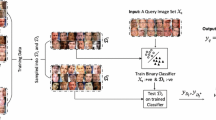Abstract
In this paper, a novel framework for face recognition, namely Selective Ensemble of Image Regions (SEIR), is proposed. In this framework, all possible regions in the face image are regarded as a certain kind of features. There are two main steps in SEIR: the first step is to automatically select several regions from all possible candidates; the second step is to construct classifier ensemble from the selected regions. An implementation of SEIR based on multiple eigenspaces, namely SEME, is also proposed in this paper. SEME is analyzed and compared with eigenface, PCA + LDA, eigenfeature, and eigenface + eigenfeature through experiments. The experimental results show that SEME achieves the best performance.
Similar content being viewed by others
Explore related subjects
Discover the latest articles and news from researchers in related subjects, suggested using machine learning.References
Turk M, Pentland A. Eigenfaces for recognition. Journal of Cognitive Neuroscience, 1991, 3(1): 71–86.
Moghaddam B, Pentland A. Probabilistic visual learning for object representation. IEEE Transactions on Pattern Analysis and Machine Intelligence, 1997, 19(7): 696–710.
Jolliffe I T. Principal Component Analysis. New York: Springer-Verlag, 1986.
Moghaddam B, Jebara T, Pentland A. Bayesian face recognition. Pattern Recognition, 2000, 33(11): 1771–1782.
Pentland A, Moghaddam B, Starner T. View-based and modular eigenspaces for face recognition. In Proc. IEEE Conference on Computer Vision and Pattern Recognition, Seattle, WA, 1994, pp.84–91.
Brunelli R, Poggio T. Face recognition: Feature versus templates. IEEE Trans. Pattern Analysis and Machine Intelligence, 1993, 15(10): 1042–1052.
Zhou Z H, Wu J, Tang W. Ensembling neural networks: Many could be better than all. Artificial Intelligence, 2002, 137(1-2): 239–263.
Penev P S, Atick J J. Local feature analysis: A general statistical theory for object representation. Network: Computation in Neural Systems, 1996, 7: 477–500.
Yang P, Shan S, Gao W, Li S Z, Zhang D. Face recognition using AdaBoosted Gabor features. In Proc. the 6th International Conference on Automatic Face and Gesture Recognition, Seoul, Korea, 2004, pp.356–361.
Krogh A, Vedelsby J. Neural Network Ensembles, Cross Validation, and Active Learning. Advances in Neural Information Processing Systems 7, Tesauro G, Touretzky D, Leen T (eds.), Cambridge, MA: MIT Press, 1995, pp.231–238.
Moghaddam B, Wahid W, Pentland A. Beyond eigenfaces: Probabilistic matching for face recognition. In Proc. the IEEE International Conference on Automatic Face and Gesture Recognition, Nara, Japan, 1998, pp.30–35.
Moghaddam B. Principal manifolds and probabilistic subspaces for visual recognition. IEEE Trans. Pattern Analysis and Machine Intelligence, 2002, 24(6): 780–788.
Zhao W, Chellappa R, Philips P. Subspace linear discriminant analysis for face recognition. Technical Report CAR-TR-914. Center for Automation Research, University of Maryland, 1999.
Ho T K. Nearest Neighbors in Random Subspaces. In Lecture Notes in Computer Science 1451, Amin A, Dori D, Pudil P, Freeman H (eds.), Berlin: Springer, 1998, pp.640–648.
Lowe D. Similarity metric learning for a variable-kernel classifier. Neural Computation, 1995, 7(1): 72–85.
Phillips P J, Wechsler H, Huang J, Rauss P J. The FERET database and evaluation procedure for face-recognition algorithms. Image and Vision Computing, 1998, 16(5): 295–306.
Martinez A M, Benavente R. The AR face database. CVC Technical Report #24, June 1998.
Samaria F, Harter A. Parameterisation of a stochastic model for human face identification. In Proc. the 2nd IEEE International Workshop on Applications of Computer Vision, Sarasota, FL, 1994, pp.138–142.
The BioID face database. BioID-Technology Research, June 2001. http://www.bioid.com/research/in-dex.htm.
Poggio T, Girosi F. A theory of networks for recognize three-dimensional objects. Nature, 1990, 343(6225): 1–3.
Author information
Authors and Affiliations
Corresponding author
Additional information
Supported by the National Science Foundation of China under Grant Nos. 60325207, 60496320, the Fok Ying Tung Education Foundation under Grant No. 91067, and the Excellent Young Teachers Program of MOE of China.
Xin Geng received the B.Sc. and M.Sc. degrees in computer science from Nanjing University, China, in 2001 and 2004 respectively. Currently he is a research and teaching assistant at the Department of Computer Science & Technology of Nanjing University, and a member of the LAMDA group. His research interests are in machine learning, pattern recognition and computer vision.
Zhi-Hua Zhou received the B.Sc., M.Sc. and Ph.D. degrees in co-mputer science from Nanjing University, China, in 1996, 1998 and 2000, respectively, all with the highest honor. He joined the Department of Computer Science & Technology of Nanjing University as a lecturer in 2001, and is a professor and leader of the LAMDA group at present. His research interests are in machine learning, data mining, pattern recognition, information retrieval, neural computing, and evolutionary computing. In these areas he has published over 60 technical papers in refereed international journals or conference proceedings. He has won the Microsoft Fellowship Award (1999), the National Excellent Doctoral Dissertation Award of China (2003), and the award of National Science Fund for Distinguished Young Scholars of China (2004). He is an associate editor of Knowledge and Information Systems, and on the editorial boards of Artificial Intelligence in Medicine, International Journal of Data Warehousing and Mining, Journal of Computer Science & Technology, and Journal of Software. He served as program committee member for various international conferences and chaired a number of native conferences. He is a senior member of China Computer Federation (CCF) and the vice chair of CCF Artificial Intelligence & Pattern Recognition Society, an executive committee member of Chinese Association of Artificial Intelligence (CAAI), the vice chair and chief secretary of CAAI Machine Learning Society, and a senior member of IEEE.
Rights and permissions
About this article
Cite this article
Geng, X., Zhou, ZH. Image Region Selection and Ensemble for Face Recognition. J Comput Sci Technol 21, 116–125 (2006). https://doi.org/10.1007/s11390-006-0116-7
Received:
Accepted:
Issue Date:
DOI: https://doi.org/10.1007/s11390-006-0116-7




